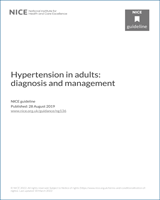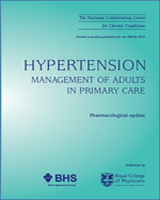All rights reserved. No part of this publication may be reproduced in any form (including photocopying or storing it in any medium by electronic means and whether or not transiently or incidentally to some other use of this publication) without the written permission of the copyright owner. Applications for the copyright owner’s written permission to reproduce any part of this publication should be addressed to the publisher.
NCBI Bookshelf. A service of the National Library of Medicine, National Institutes of Health.
National Collaborating Centre for Chronic Conditions (UK). Hypertension: Management in Adults in Primary Care: Pharmacological Update. London: Royal College of Physicians (UK); 2006. (NICE Clinical Guidelines, No. 34.)
This publication is provided for historical reference only and the information may be out of date.
- Adverse events
A harmful, and usually relatively rare, event arising from treatment.
- Algorithm (in guidelines)
A flowchart of the clinical decision pathway described in the guideline.
- Allocation concealment
The process used to prevent advance knowledge of group assignment in an RCT, and potential bias that may result.
- Audit
See ‘clinical audit’.
- Bias
The effect that the results of a study are not an accurate reflection of any trends in the wider population. This may result from flaws in the design of a study or in the analysis of results.
- Blinding (masking)
A feature of study design to keep the participants, researchers and outcome assessors unaware of the interventions which have been allocated.
- Carer (caregiver)
Someone other than a health professional who is involved in caring for a person with a medical condition, such as a relative or spouse.
- Class of recommendation
All recommendations are assigned a class (A, B, C) according to the level of evidence the recommendation is based on (see ‘level of evidence’).
- Clinical audit
A quality improvement process that seeks to improve patient care and outcomes through systematic review of care against explicit criteria and the implementation of change.
- Clinician
In this guideline, the term clinician means any healthcare professional.
- Cochrane review
A systematic review of the evidence from randomised controlled trials relating to a particular health problem or healthcare intervention, produced by the Cochrane Collaboration. Available electronically as part of the Cochrane Library.
- Cohort study
A retrospective or prospective follow-up study. Groups of individuals to be followed up are defined on the basis of presence or absence of exposure to a suspected risk factor or intervention. A cohort study can be comparative, in which case two or more groups are selected on the basis of differences in their exposure to the agent of interest.
- Concordance
Concordance is a concept reflecting agreement between clinicians and patient on the best course of managing a disease, and adherence to that course until alternatives are agreed on and adopted.
- Confidence interval (CI)
A range of values which contains the true value for the population with a stated ‘confidence’ (conventionally 95%). The interval is calculated from sample data, and generally straddles the sample estimate. The 95% confidence interval means that if the study, and the method used to calculate the interval, is repeated many times, then 95% of the calculated intervals will actually contain the true value for the whole population.
- Cost-effectiveness model
An explicit mathematical framework, which is used to represent clinical decision problems and incorporate evidence from a variety of sources in order to estimate the costs and health outcomes.
- Discounting
The process of converting the cost or benefits to be incurred or received at different points in the future to a present value so that they can be compared in commensurate units as if they all occur at the same point in time.
- Dominance
A situation where an intervention is more effective clinically and less costly than its comparator.
- Evidence-based healthcare
The process of systematically finding, appraising, and using research findings as the basis for clinical decisions.
- Extended dominance
A situation where treating patients with a combination of two drugs is estimated to be cheaper and more effective than using one drug.
- Fixed effects model
A mathematical model that can be used in meta-analyses to calculate a pooled estimate of the effect size. It assumes that each trial is reporting an estimate of a single underlying ‘fixed’ effect size.
- Follow-up
An attempt to measure the outcomes of an intervention after the intervention has ended.
- Generalisability
The degree to which the results of a study or systematic review can be extrapolated to other circumstances, particularly routine healthcare situations in the NHS in England and Wales.
- Grade of recommendation
See ‘class of recommendation’.
- Guideline Development Group (GDG)
An independent group set up on behalf of NICE to develop a guideline. They include healthcare professionals and patient and carer representatives.
- Hazard ratio (HR)
A statistic to describe the relative risk of complications due to treatment, based on a comparison of event rates.
- Heterogeneity
In systematic reviews, heterogeneity refers to variability or differences between studies in estimates of effect.
- Homogeneity
In a systematic review, homogeneity means there are no or minor variations in the results between individual studies included in a systematic review.
- Inclusion criteria
Explicit criteria used to decide which studies should be considered as potential sources of evidence.
- Incremental cost
The cost of one alternative less the cost of another.
- Incremental cost-effectiveness ratio (ICER)
The ratio of the difference in costs between two alternatives to the difference in effectiveness between the same two alternatives.
- Intention-to-treat analysis (ITT analysis)
An analysis of the results of a clinical study in which the data are analysed for all study participants as if they had remained in the group to which they were randomised, regardless of whether or not they remained in the study until the end, crossed over to another treatment or received an alternative intervention.
- Level of evidence
A code (eg I, II) linked to an individual study, indicating where it fits into the hierarchy of evidence and how well it has adhered to recognised research principles.
- Meta-analysis
A statistical technique for combining (pooling) the results of a number of studies that address the same question and report on the same outcomes to produce a summary result.
- Methodological limitations
Features of the design or reporting of a clinical study, which are known to be associated with risk of bias or lack of validity. Where a study is reported in this guideline as having significant methodological limitations, a recommendation has not been directly derived from it.
- National Collaborating Centre for Chronic Conditions (NCC-CC)
A partnership of the Clinical Effectiveness Forum for Allied Health Professions, the NHS Confederation, the NICE Patient & Public Involvement Programme, the Royal College of General Practitioners, the Royal College of Nursing, the Royal College of Physicians of London, the Royal College of Physicians’ Patient Involvement Unit, the Royal College of Surgeons of England and the Royal Pharmaceutical Society of Great Britain. Set up in 2001 to undertake commissions from NICE to develop clinical guidelines for the NHS.
- National Health Service (NHS)
This guideline is written for the NHS in England and Wales.
- National Institute for Health and Clinical Excellence (NICE)
NICE is the independent organisation responsible for providing national guidance on the promotion of good health and the prevention and treatment of ill health.
- Observational study
Retrospective or prospective study in which the investigator observes the natural course of events with or without control groups, for example cohort studies and case-control studies.
- Odds ratio
A measure of treatment effectiveness. The odds of an event happening in the intervention group, divided by the odds of it happening in the control group. The ‘odds’ is the ratio of non-events to events.
- Outcome
Measure of the possible results that may stem from exposure to prevention or therapeutic intervention. Outcome measures may be intermediate endpoints or they can be final endpoints.
- p-values
The probability that an observed difference could have occurred by chance. A p-value of less than 0.05 is conventionally considered to be ‘statistically significant’.
- Placebo
An inactive and physically indistinguishable substitute for a medication or procedure, used as a comparator in controlled clinical trials.
- Quality of life
Refers to the level of comfort, enjoyment and ability to pursue daily activities.
- Quality-adjusted life year (QALY)
A measure of health outcome which assigns to each period of time a weight, ranging from 0 to 1, corresponding to the health-related quality of life during that period, where a weight of 1 corresponds to optimal health, and a weight of 0 corresponds to a health state judged equivalent to death; these are then aggregated across time periods.
- Random effects model
A mathematical model that can be used in meta-analyses to calculate a pooled estimate of the effect size. In contrast to a fixed effects model, it assumes that each trial contributes its own underlying effect, independently of the others. This is a useful approach when dealing with heterogeneous trials.
- Randomisation
Allocation of participants in a study to two or more alternative groups using a chance procedure, such as computer-generated random numbers. This approach is used in an attempt to reduce sources of bias.
- Randomised controlled trial (RCT)
A comparative study in which participants are randomly allocated to intervention and control groups and followed up to examine differences in outcomes between the groups.
- Relative risk (RR)
An estimate for the number of times more likely or less likely an event is to happen in one group of people compared with another, based on the incidence of the event in the intervention arm of a study, divided by the incidence in the control arm.
- Sample size
The number of participants included in a trial or intervention group.
- Sensitivity analysis
A measure of the extent to which small changes in parameters and variables affect a result calculated from them. In this guideline, sensitivity analysis is used in health economic modelling.
- Single blind study
A study where the investigator is aware of the treatment or intervention the participant is being given, but the participant is unaware.
- Specialist
A clinician whose practice is limited to a particular branch of medicine or surgery, especially one who is certified by a higher medical educational organisation.
- Stakeholder
Any national organisation, including patient and carers’ groups, healthcare professionals and commercial companies with an interest in the guideline under development.
- Statistical power
In clinical trials, the probability of correctly detecting an underlying difference of a pre-specified size due to the intervention or treatment under consideration. Power is determined by the study design, and in particular, the sample size. Larger sample sizes increase the chance of small effects being correctly detected as statistically significant, though they may not be clinically significant.
- Statistical significance
A result is deemed statistically significant if the probability of the result occurring by chance is less than 1 in 20 (p<0.05).
- Systematic review
Research that summarises the evidence on a clearly formulated question according to a pre-defined protocol using systematic and explicit methods to identify, select and appraise relevant studies, and to extract, collate and report their findings. It may or may not use statistical meta-analysis.
- Withdrawal
When a trial participant discontinues the assigned intervention before completion of the study.
- Glossary - HypertensionGlossary - Hypertension
Your browsing activity is empty.
Activity recording is turned off.
See more...

